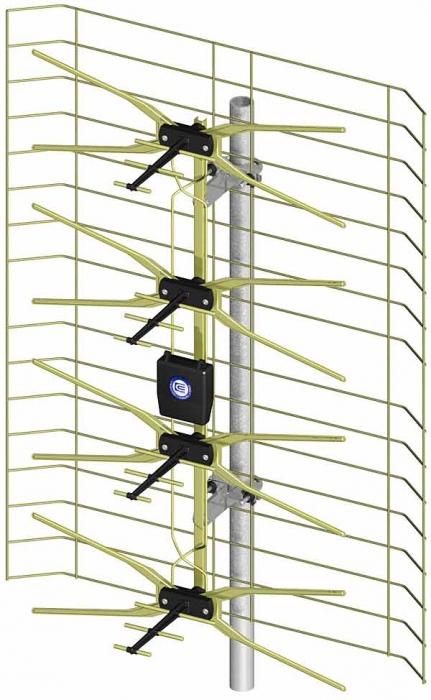
Currently, there is one orseveral TVs. An antenna is needed to organize the broadcast of television signals. There are many types of receivers. They are divided by purpose, type of signals received, shape, size and so on. The subject of our today's conversation will be the receiving television antennas.
Each of us in his life in one way or anotherencountered these devices. A television antenna is a metal structure, most often made of aluminum, designed to receive a radio signal. Depending on the type of television range being received, they are divided into meter and decimeter devices. Also they are divided in the place of installation for indoor and outdoor use. By way of signal reception, the television antenna can be active or passive.

Let's consider the main types of receiving devices:
1. A dipole or an inclined vibrator. They are quarter-wave, half-wave and wave. In the latter, the length of the vibrator corresponds to the wavelength of the signal that is received; half-wave - half signal; and, accordingly, quarter-wave - quarter. At the dipole, the impedance is 300 Ohm, in order to match the antenna with the TV and the receiving cable under amateur conditions, a matching half-wave loop is often used. For all TV antennas, the drop cable has a impedance of 75 ohms. The dipole, in fact, is an analog of a room antenna.
2. Television antenna type "wave channel" can be: two-element, three-element, five-element, seven-element, eleven element and sixteen-element. The looper is not used independently, it is an active element for antennas of this type. The "wave channel" antenna consists of an active element (a vibrator, more often a loop) and passive elements: a reflector and directors mounted on a common boom. Director - a passive vibrator, located in front of an active vibrator. The reflector is a vibrator located behind the active one. For antennas of this type, there is one drawback: when adding passive elements to the wave vibrator, the input impedance of the antenna decreases. Receiving devices of this type are widely used in radar and radio communication devices.

3. Logoperiodic TV antenna is a broadband device that provides reception of signals in the frequency range (decimeter and meter waves). In the working range, optimum matching of the antenna and the feeder is achieved, while the gain remains constant.
4. Frame television antennas are designed to receive signals, in cases where the "wave channel" antennas are not able to provide a satisfactory signal quality. They are a double or a triple square. Devices of this type combine high gain and simple design, do not require adjustment.
5. Common-mode gratings are a complex directional system consisting of low-directional antennas that are spaced apart in space, they are arranged in such a way that the phases of the signals are obtained the same. As a rule, they are assembled from identical antennas arranged in several rows and connected to an electronic unit. Common-mode receivers are television antennas with amplifiers.

In conclusion, let's say that the choice of an antenna should be approached individually, depending on local geographical conditions, from the installation site and the required result.
</ p>